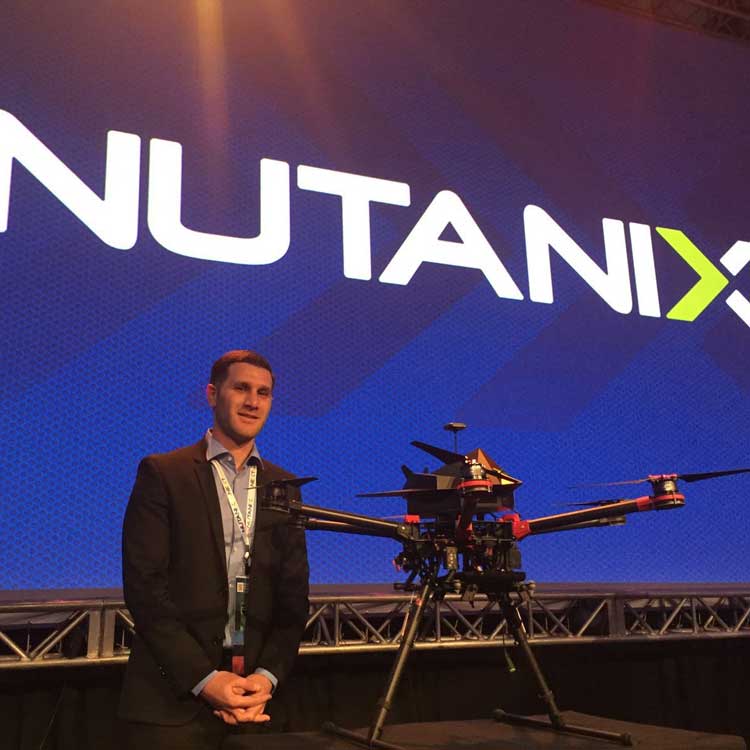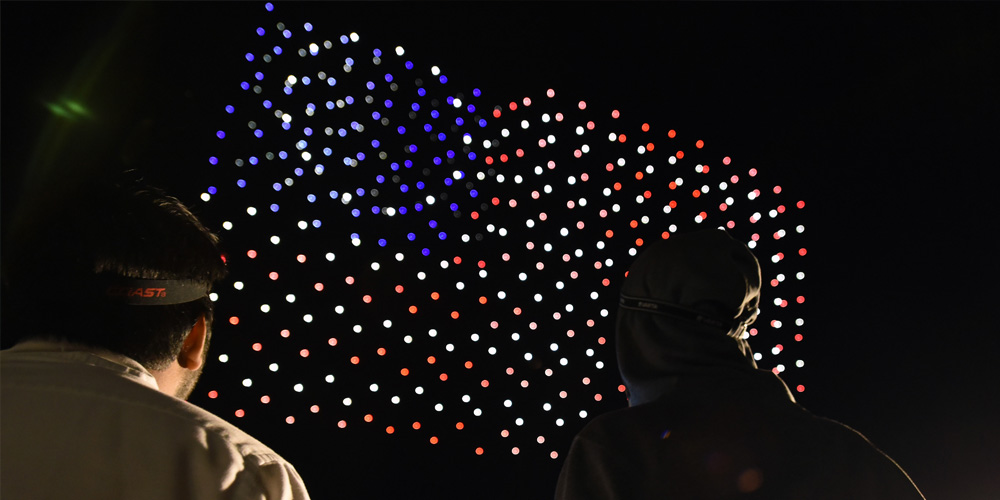Surging through everyone’s pockets, homes, cars and skies is a never-ending flow of information. Data collection, once entirely Earth-bound, is no longer limited by physical capabilities. Airborne drones allow people to photograph, video, map, survey and inspect where nobody can physically be, powering a vast world of industries with real-time insights. But where is drone data stored and how can it become an essential part of a company’s digital transformation? “Think of drones or any autonomous physical technology as a part or a node in a broader network that’s gathering data and is interconnected with cloud computing,” said Brian David Johnson, a futurist in residence and professor of practice at Arizona State University. “The drone is simply an autonomous data-gathering machine.”
Unmanned aerial vehicles (UAVs) are autonomous sensors in the sky, capturing high-resolution imagery that informs decision making with increased speed and efficiency, and decreased cost. They can assist with predictive maintenance to increase uptime at a factory, ensure safety compliance at a commercial construction site, and fundamentally change the telecommunication industry.
The COVID-19 pandemic only accelerated this drone revolution and the investment in making drones faster and more agile in data collection and processing. When coupled with edge or cloud computing, these hovering data collection devices provide faster insights, according to Colin Guinn, Founder of Guinn Partners, a drone consulting company.
“The whole point of a drone is you can fly a sensor around and capture data,” said Guinn. “A drone is basically a way to position a high-resolution imaging sensor in places you couldn’t before.”
Storing Drone Data
The cloud is perhaps the next frontier in expediting the drone workflow by helping companies synthesize data while the device is still airborne, according to Anil Nanduri, Vice President and General Manager of the Drone Group at Intel.
“You're seeing a lot of processing move towards the cloud, just like any trends in the computer ecosystem,” said Nanduri. “Cloud has become the compute engine for large applications, and it's no different for the drone ecosystem.”
Intel uses edge and cloud computing for commercial companies in construction, oil and gas, and utilities.
“We are leveraging the ability of the cloud to learn faster, to iterate faster and to deploy,” Nanduri said. “The cloud allows that inference and learning so you can make drones smarter – it's like an interactive cycle. Cloud becomes your learning step, and then edge becomes your evolution step.”
The advent of a 5G network is essential to drones’ increased dependence on cloud computing, especially as fleets of drones work together to gather heaps of data at one time.
“In the future, it will go from the drones’ imaging sensors straight to the cloud over 5G to be processed and stored in the cloud,” said Guinn, who is also the founder of Hangar Technology and is the former CEO of DJI in North America. “You’ll have faster time to realize accurate insights and information and real-time decisions can be made in the air.”
“You can have almost instantaneous situational awareness,” said Professor Johnson. “You can actually know what’s going on. Getting information that you need, when you need it.”
Previously, drone operations relied exclusively on human middlemen to land the UAVs and transfer data from the devices into the cloud while on the ground. It then took operational downtime for the software to make sense of the information that the drone had collected.
From the Edge to Cloud
Now, many UAVs have edge computing onboard, said Guinn.
“They can do things like object recognition or object detection – they can detect rust on a bridge or see if vegetation and trees are growing on a power line. They’re doing some computer vision and machine learning in the air and in real-time.”
Some companies employ drones in a box or an autonomous drone station (ADS), which is a self-contained edge computing container that deploys drones in regular intervals or as needed.
“It comes out, takes all the images, then goes back into the box where there’s an edge computer,” Guinn said.
In the agricultural industry, these stations can automatically alert farmers of problems with crops in their fields. When connected to cloud-computing, this data empowers farmers to make quicker, more informed decisions. For security, a drone can deploy when an intruder is detected in a restricted area. Even indoors, a drone can work with an edge computer to help manage a warehouse’s inventory.
In addition to speeding up insights from data collected in the sky, cloud computing may impact the hardware of drones too.
“Cloud computing is going to really change the architecture of drones and actually greatly simplify the flying robots,” said Guinn. “Once the drone has a low latency, high bandwidth and a highly reliable connection to the cloud, the drone at that point only has to carry sensors – it doesn’t have to carry compute power.”
This will allow for smarter drones to collect larger amounts and types of data, as data storage and analysis processes become more complex.
“Data management and the whole data stream is really important, as is identifying early on how that’s going to work,” said Capt. Phil Hall, director of the NOAA Uncrewed Systems Operations Center in the Office of Marine and Aviation Operations in an interview with FedTech. “We don’t have any sort of overloads at this time, but we expect as we start going to 24/7 operations and more systems that this will become a very important issue.”
Hall said that data archiving and cloud storage networking are all top priorities as the NOAA continues to use fleets of drones to monitor and understand everything from hurricanes to the Arctic seafloor. Cloud computing storage and artificial intelligence provide researchers with vital insights after the drones collect massive amounts of data.
The Future of Flying Cloud Computers
Companies utilize the power of drone technology to aid in their digital transformations. From drone deliveries in the commerce world to eco-friendly firework displays in the entertainment industry, cloud-powered drones are poised for takeoff.
But it's not just enterprises that benefit from the new ways drone data is collected and stored, new insights can rescue our forests and feed our world.
These insights leverage the huge amounts of data collected from the drones across industries and, as Johnson says, begins to create a world that is truly interconnected across the land and sky.
“Now that we have a much broader articulated network of sensors with cloud computing, the whole world itself nearly becomes a computer,” he said. “We can now start to optimize the physical world using all this data.”
Editor’s note: This is an updated version of an article that originally appeared on October 18, 2019.
Jacob Gedetsis contributed revisions. His work has appeared in The Kansas City Star, The Post Standard and The Plain Dealer, among others. Find him on Twitter @JacobGedetsis.
Chase Guttman is a contributing writer specializing in drones. He authored the critically acclaimed book The Handbook of Drone Photography. Find him on Twitter @chaseguttman.
© 2022 Nutanix, Inc. All rights reserved. For additional legal information, please go here.





